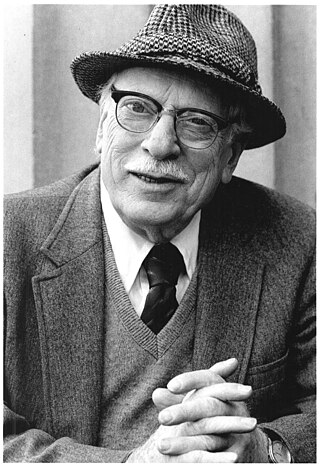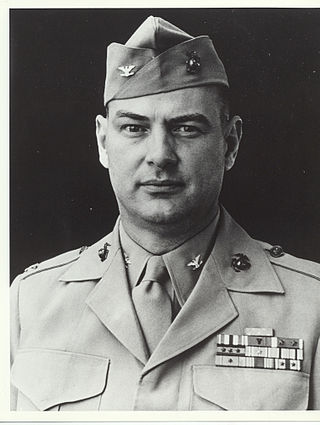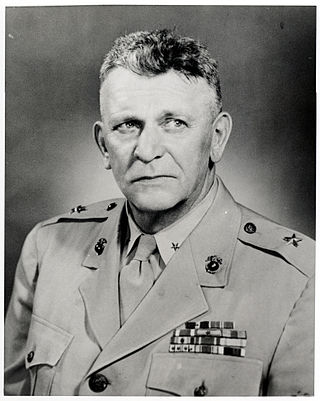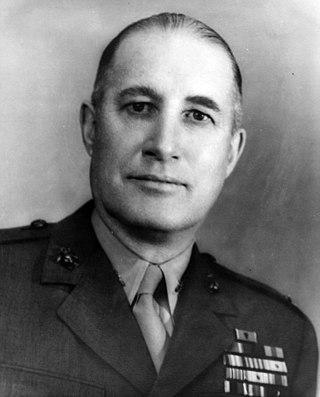
Ira Hamilton Hayes was an Akimel O'odham Indigenous American and a United States Marine during World War II. Hayes was an enrolled member of the Gila River Indian Community, located in Pinal and Maricopa counties in Arizona. He enlisted in the United States Marine Corps Reserve on August 26, 1942, and, after recruit training, volunteered to become a Paramarine. He fought in the Bougainville and Iwo Jima campaigns in the Pacific War.

Joseph John Rosenthal was an American photographer who received the Pulitzer Prize for his iconic World War II photograph Raising the Flag on Iwo Jima, taken during the 1945 Battle of Iwo Jima. His picture became one of the best-known photographs of the war, and was replicated as the United States Marine Corps War Memorial in Arlington, Virginia.

René Arthur Gagnon was a United States Marine Corps corporal who participated in the Battle of Iwo Jima during World War II.

Franklin Runyon Sousley was a United States Marine who was killed in action during the Battle of Iwo Jima in World War II. He was one of the six marines who raised the second of two U.S. flags on top of Mount Suribachi on February 23, 1945, as shown in the iconic photograph Raising the Flag on Iwo Jima.

Joseph Jeremiah McCarthy was a mustang officer in the United States Marine Corps Reserve, who served during World War II and the Korean War. He was also the Superintendent of Ambulances in the Chicago Fire Department; however, with respect for his wartime heroics, firefighters continued to address him by his wartime military rank of “Captain.”

Colonel Justice Marion Chambers was a United States Marine Corps officer who received the Medal of Honor for actions in World War II during the Iwo Jima campaign.

The 23rd Marine Regiment is a reserve infantry regiment of the United States Marine Corps. It is headquartered in San Bruno, California and falls under the command of the 4th Marine Division and the Marine Forces Reserve.

Brigadier General Harry Bluett Liversedge, whose regiment figured in the historic raising the flag on Iwo Jima, was a United States Marine who died in 1951 after almost 25 years of service. His last assignment was as director of the Marine Corps Reserve.
Louis R. Lowery was a United States Marine Corps captain. He was the only Marine Corps combat photographer to cover six major campaigns during World War II. He is best known for taking the first photographs of the first American flag that was raised on top of Mount Suribachi during the Battle of Iwo Jima on the morning of February 23, 1945.

Ernest Ivy "Boots" Thomas Jr. was a United States Marine Corps platoon sergeant who was killed in action during the Battle of Iwo Jima in World War II. He was awarded the Navy Cross for extraordinary heroism while fighting for and at the base of Mount Suribachi. Two days later he was a member of the patrol that captured the top of Mount Suribachi where he helped raise the first U.S. flag on Iwo Jima on February 23, 1945. He was killed eight days after that.
Harold George Schrier was a United States Marine Corps lieutenant colonel who served in World War II and the Korean War. In World War II, he was awarded the Navy Cross for leading the patrol that captured the top of Mount Suribachi, where he helped raise the first U.S. flag on Iwo Jima on February 23, 1945. In the Korean War, he was wounded in North Korea during the Battle of Chosin Reservoir while commanding a rifle company.

Alpha Lyons Bowser was a United States Marine Corps lieutenant general. He was a combat veteran of World War II and the Korean War – decorated for his actions during the Battle of Iwo Jima and in the Battle of Chosin Reservoir.

Naval Mobile Construction Battalion 133 is a United States Navy Construction Battalion, otherwise known as a Seabee battalion, homeported at the Naval Construction Battalion Center. The unit was formed during WWII as the 133rd Naval Construction Battalion. It saw action and was decommissioned shortly after the war ended. The unit was reactivated as Mobile Construction Battalion 133 for the Vietnam War and remains an active unit today.

Henry Pierson Crowe was a Marine of World War I, the Banana Wars, World War II, and the Korean War.

Lawrence Fontaine Snowden was a lieutenant general in the United States Marine Corps. In 1995, he founded the annual Reunion of Honor, a program honoring those who lost their lives on both sides of the Battle of Iwo Jima.

Harold Henry Schultz was a United States Marine corporal who was wounded in action during the Battle of Iwo Jima in World War II. He was a member of the patrol that captured the top of Mount Suribachi and raised the first U.S. flag on Iwo Jima on February 23, 1945. He is also one of the six Marines who raised the larger replacement flag on the mountaintop the same day as shown in the iconic photograph Raising the Flag on Iwo Jima.

Thomas Andrews Wornham was a highly decorated officer of the United States Marine Corps with the rank of lieutenant general. He is most noted for his service as commanding officer of the 27th Marine Regiment during the Battle of Iwo Jima or as commanding officer of the 1st Marine Regiment during the Korean War.

David Anderson Stafford was a decorated officer of the United States Marine Corps with the rank of brigadier general. He is most noted for his service as assistant chief of staff for personnel (G-1) of V Amphibious Corps during Battle of Iwo Jima.

Harold Paul Keller was a United States Marine corporal who was wounded in action during the Bougainville campaign in World War II. During the Battle of Iwo Jima, he was a member of the patrol that captured the top of Mount Suribachi and raised the first U.S. flag on Iwo Jima on February 23, 1945. He is one of the six Marines who raised the larger replacement flag on the mountaintop the same day as shown in the iconic photograph Raising the Flag on Iwo Jima.

















